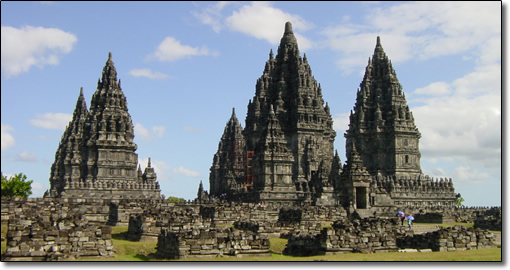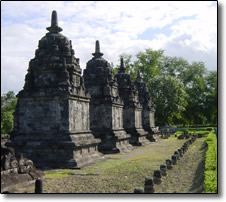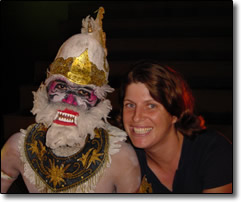
Prambanan
To get to Prambanan, the largest Hindu temple in Indonesia, we rented a motorbike and followed a narrow canal that led out of Yogyakarta. Built about the same time as Borobudur, Prambanan’s vertical profile is strikingly imposing. There are three grand temples: to Brahma, the creator, to Vishnu, the preserver and, the largest, to Shiva, the destroyer. In front of the main ones are smaller temples to the divine “vehicles” (or mounts) of the three gods: the goose Angsa, the man-eagle Garuda, and the bull Nandi. Along the sides of the temples were detailed bas-reliefs depicting scenes from the Ramayana.
 |
 |
The arrangement of larger temples faced by smaller ones of the same form reminded us of folk architectural traditions in other parts of Indonesia, like the houses and rice barns of Tanah Toraja. We lingered at the site, taking a guided tour from two tourism students who wanted to practice their English. The vertical harmony of the temples, especially the decorative Shiva temple, was extraordinary. Cylindrical and rectangular elements in the design were used in a fashion we had seen nowhere else in South-East Asia. After watching the sun set beside Mt. Merapi, rising above the clouds in the distance, we walked behind the temples to an open-air theater to watch a performance of the Ramayana. To the pulsing beat of the live gamelan orchestra, hundreds of dancers took to the stage as the full moon rose behind the Shiva temple. The principal performers were nimble and graceful, expressive and precise. It was the best Ramayana we had seen. At the end of the performance Hanuman, the mischievous monkey-king, set fire to the demon-city of Lanka, torching a pile of straw at the back of the stage.
 |
 |
From Yogyakarta, it was a long, slow return journey by train to Surabaya, then a train-bus combination to Bali. At the main bus station, we chartered a ride in an empty bemo to Kuta. Here was a different side of tourism in Indonesia. Everything looked clean and modern, like the shopping districts of Singapore or Malaysia. There were chic boutiques selling designer clothes and high-priced souvenirs. The tourists were mainly interested in parties and drinking. We walked around, looking for a place to change enough money for the next month in Papua, and found the Bali bomb memorial. It is not hard to understand why the bomb was placed here - if you want to target tourists, this is the best place in Indonesia.
